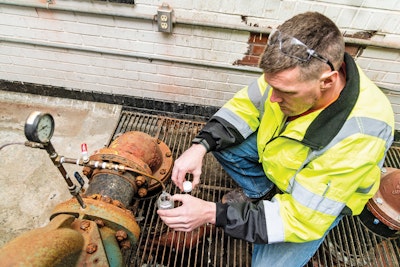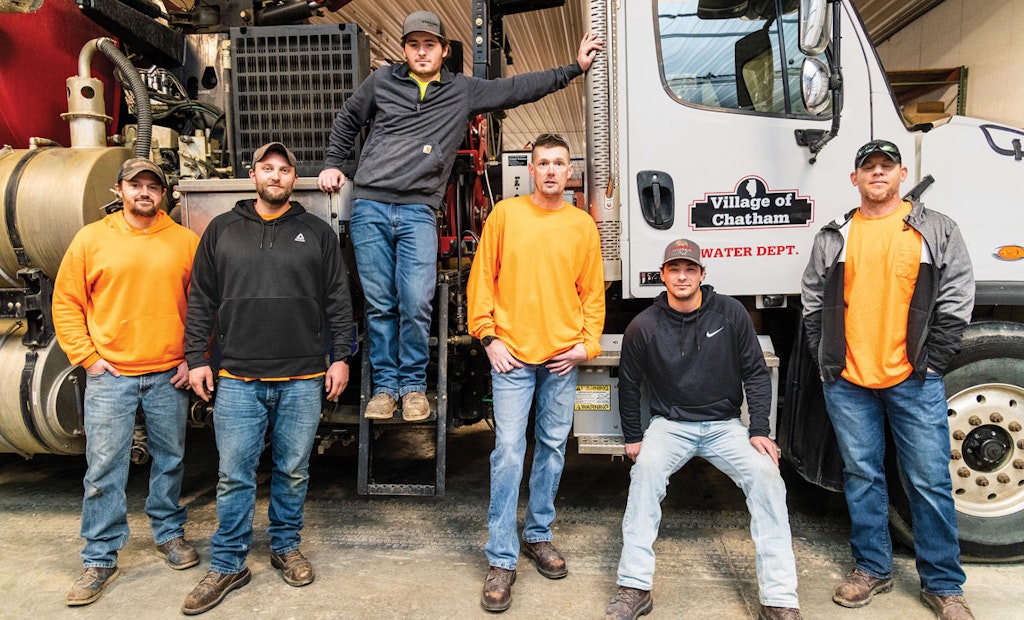Interested in Infrastructure?
Get Infrastructure articles, news and videos right in your inbox! Sign up now.
Infrastructure + Get AlertsDuring the last 10 years, the Chatham Water and Sewer Department has overcome a series of significant challenges: A controversial conversion to a new water plant. A resulting problem with high levels of manganese in the water. The subsequent adoption of a unidirectional water-main flushing program.
In addition, a major water tank painting project took the central Illinois village’s two water tanks offline for several months each.
But through it all, employee J.D. Crawford was a calm and steadying influence on the department’s other employees, always leading by example and getting the job done, says Dustin Patterson, general foreman of water, sewer and parks for the village. Chatham is located about 10 miles south of Springfield, in central Illinois.
Crawford’s skills and leadership ability are the chief reasons the 39-year-old water and sewer foreman, who joined the village utility in 2015, was named the 2021 Operator of the Year for distribution systems by the Illinois Potable Water Supply Operators Association.
“J.D. definitely is a leader for our department,” Patterson says. “He’s been very resilient while dealing with some complications from our water changeover, which occurred in 2012. He was out there helping residents even when social media outlets weren’t very kind to our department.
“We’re in a good place now and a lot of that is because of J.D.”
Along with being ultra-dependable, Crawford also is very willing to show younger team members how to do things. He’s also been known to go back to customers’ homes after work to help them with issues on his own time.
As an example, Patterson cites an instance several years ago where a resident had a water leak on the homeowner’s side of the meter. The resident, an older man, said he would fix it himself. So Crawford went to the man’s home and explained what kind of parts he’d need and how to make the repair, Patterson says.
Big surprise
“It’s the first time in my life I literally was speechless,” Crawford says about his reaction when the IPWSOA announced he won the Operator of the Year award at an annual conference. “I don’t have a problem with public speaking or talking to people, but I couldn’t say a word.”
Crawford also gives credit to his colleagues, Patterson and Patrick McCarthy, the village manager.
“I wouldn’t be able to do the things I do without the work and support of my very dedicated crew,” he says. “Patrick McCarthy has always supported me and never doubted me, even through the toughest of times.
“And I couldn’t ask for a better boss than Dustin — he understands all aspects of the job and can relate to any situation and help out.”
A former paramedic, Crawford started his water industry career in 2004 as a maintenance worker in the Water Department in Petersburg, about 25 miles northwest of Springfield. After seven years there, he took a job as a maintenance employee in the Department of Public Works in Rochester, just east of Springfield.
Crawford worked there for four years before joining the Chatham utility in 2015.
Crawford earned a water operator’s certificate from the Illinois Environmental Protection Agency in 2005. He also has a collections system operator certificate for sanitary sewers, which he obtained in 2012.
“I enjoy my job because every day presents something different,” he says. “I’m a hands-on problem solver. Sure, it sucks when problems come up, but I enjoy solving them.
“I don’t quit until I figure a problem out. And I learn a lot from solving those problems, which is one reason I like it when problems come up.”
Good influence
It’s second nature for Crawford to go out of his way to help customers after hours.
“It all goes back to solving problems, plus I love to be able to help people,” he explains. “It’s always been my nature to help people. That’s why I was a paramedic a long time ago.
“As long as people are kind and courteous, I’ll bend over backwards to help them and maybe save them some money. I guess that mentality was beaten into my brain my parents, who always taught me that if [you’re] kind to other people, they’ll be kind to you.”
Crawford also gives a lot of credit to his former boss and mentor, the late Roger Davis, who was head of the Petersburg Water Department.
“He was way more than just my boss because I lived next door to him since I was 8 years old and his son, Korrie, and I were best friends,” he says. “He was like a second father to me.”
Crawford says he and Korrie — they now work together in Chatham — often accompanied Davis to the water plant.
“Working under Roger definitely set the bar high for me. He gave me a window into that world. … I saw how that little world fell on his shoulders and how he kept it all together.
“I wouldn’t be working in the water industry if not for him.”
Water issues emerge
That mentoring came in handy when Crawford joined the water department in Chatham, which has 108 miles of water mains (mostly PVC pipes, plus a mix of cast and ductile iron pipes), 6,900 service connections and 799 fire hydrants.
For a variety of reasons, village officials had decided in 2010 to join with nearby New Berlin to form the South Sangamon Water Commission, which would own and operate a new water plant in Rochester.
The $31 million water plant went online in 2012, but water quality issues soon emerged in the form of high levels of manganese, a naturally occurring mineral found in rocks, soil and groundwater. While it’s an essential mineral for proper nutrition, it can be harmful in elevated concentrations.
The manganese levels in Chatham’s water rarely exceeded the secondary standard for water quality, but residents were justifiably unhappy when their tap water turned brown, Patterson says. “It was not very pleasing to the eye.”
The SSWC started adding sodium permanganate to the water, which significantly reduced the manganese levels. But manganese oxidizes and clings to pipe walls, so the village in 2019 implemented a unidirectional flushing program aimed at scouring the pipes clean.
Unidirectional flushing program
Using a plan developed by the consulting firm Crawford, Murph & Tilly Engineering, Crawford led the unidirectional flooding program.
Unidirectional flushing differs from conventional waterline flushing because water flows only in one direction — downstream from a water tank or treatment plant. Moreover, the flushing occurs only in one isolated pipe segment at a time.
By isolating sections of pipe, the velocity of the flushed water, created by opening fire hydrants, increases to 5 to 10 feet per second, compared to 1 to 3 feet per second in conventional flushing, experts estimate.
“We already had a flushing program in place before, but not as extensive as this one,” Patterson says.
The plan split the village into three zones. Under the current plan, the village flushes the mains in the biggest and most difficult zone in fall and the other two in spring.
“First we isolate the major water mains that run under our major roadways,” Patterson explains. “Then we isolate and flush the mains that branch off those major mains.
“We have three water pumps in our system, and we start from those pumps and work our way through town from there.”
The village plans to keep doing unidirectional flushing every year to minimize the presence of manganese in water mains.
Big paint job
The department also tackled another major project in late 2018 and early 2019: painting the interiors and exteriors of its two water tanks, a 1.5 million-gallon ground tank and a 120-foot-tall, 750,000-gallon elevated tank, Patterson says.
“We had to take each one out of service during the work, which was a pretty complicated process,” he says. “It’s tough around here when you have to take a tank out of service.”
The ground tank was painted during about a four-month stretch starting in January 2018. Work on the elevated tank started the following fall and finished in spring of 2019.
To maintain pressure in the system, an IT group first had to rewrite the code for the SCADA system so it performed operating calculations off the existing pressure load and not the level of water in the tanks.
“SCADA basically is the brains of our system and very vital to our operations,” Patterson says. “It reads and monitors our system’s water pressure and tells the pumps when they need to turn on to move water into the tanks and then when to shut them off.”
Under pressure
In addition, the department hired a company to deploy four large water tanker trailers, which were connected to the system via fire hydrants. The tankers provided a backup in case one of the system’s pumps failed.
Pump failures were a concern because they were working under more stress than normal to maintain the water pressure normally provided by the water tank taken out of service.
“If a pump would break down, having those water trucks would buy us some time while repairs were made,” Patterson says.
“It was a huge deal for us. It was the first time those tanks had been painted in 30 or 35 years, so the process was all new to us.”
Once again, Crawford played an instrumental role in the project’s success, Patterson says.
Crawford also helped establish a new fixed-network meter-reading system. That required converting roughly 6,900 water meters to “smart” units compatible with the new technology; about 1,400 still need to be converted.
The system collects very specific data about water usage that can be used to quickly reveal leaks in water pipes that business owners and homeowners otherwise might not find out about for some time, he says.
“We can run reports that show a customer’s water usage hour by hour.”
Looking back over the past 10 years, Patterson says he’s grateful to his team — and to Crawford for his leadership.
“It’s been a pretty crazy 10 years. But we’ve learned a lot. And one thing about J.D. — he just kept moving forward to help the citizens of this town. That’s what makes him special.
“He never complains — just keeps moving forward. I’m not sure what we’d do without him.”










